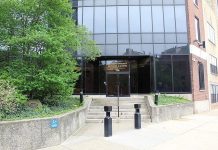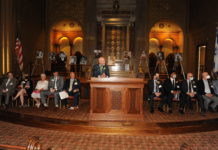
The basement of the Jewish Community Services Building looks vastly different than it did on Sept. 2, but it still bears little resemblance to what it looked like prior to Hurricane Ida.
Since then, large, rectangular chunks of drywall were removed from the wall, and 250 auditorium seats were ripped out; all salvageable pieces of memorabilia from the Philadelphia Jewish Sports Hall of Fame were packed into big, square boxes and stored in the building lobby. Industrial fans are blowing around the clock, drying the last of the water that once reached 7 feet high.
The building’s facilities team and Jewish Federation of Greater Philadelphia executives agree that progress has been steady, but slow. Robb Quattro, the building’s director of information technology and systems, has a mantra to summarize the progress made over the last three weeks: “Slow is better than no.”
Steve Rosenberg, the Jewish Federation chief operating officer, and other Jewish Federation executives aim to have staff and tenants back in the building on Oct. 4, the date originally set for many employees to return from pandemic-precipitated remote work in March 2020.
Though the Jewish Federation has committed to having employees return then, it is willing to be flexible if necessary.
“We’ve told staff to be ready for Oct. 4,” Rosenberg said. “And if you’re ready for Oct. 4, you’ll be ready for Oct. 11 or 18 or 25.”
With more employees working from home once again, remote access to the server through the previously never-before-used disaster relief site has increased to almost 30 people. Quattro has tripled the bandwidth on the virtual private network.
Facilities staff works on building repairs daily.
“The team is in here by 7 a.m. every day, really working,” Rosenberg said.
On Sept. 13, the building’s heating, ventilation and air conditioning system was up and running again, leaving the elevators as the only component of the main system still not operable.
Though facility manager Jamaal Chambers and his team lifted the two elevators in the building lobby to drain three feet of water from one elevator shaft over two days, the elevators are waiting on parts before they can be repaired.
Those elevator repairs are straightforward and likely minor; the Jewish Community Services building also has two elevators in the back — one passenger and one freight elevator — that are presenting higher hurdles to clear.
The passenger elevator in the back of the building experienced the brunt of the flooding and is too muddy to be lifted and drained of water. The freight elevator — used by the facilities staff to carry furniture and supplies throughout the building — relies on a transformer to function. Because the transformer is located at waist-level, it was entirely submerged and needs to be replaced.
In the meantime, a crew will begin cleaning the entire building, which has remained empty since the hurricane. According to Rosenberg, the cleaning process will take about two weeks. Facilities staff also discovered minor damages to the building’s roof, which will need to be repaired.
The memorabilia from the hall of fame will be assessed and cleaned by local museum specialists until it is eventually moved to a new home, which is still being decided upon by Stephen Frishberg, the hall’s chairperson.
During the building cleanup, Chambers noticed some new needed repairs that wouldn’t have otherwise been discovered — such as a leak in the lower-level bathroom behind the drywall — so he considers the building lucky, despite the existing damage.
The building is about 50 years old, but Chambers said that its age has been an asset to its integrity. The foundation of the building is brick, which is no longer the to-go material when constructing buildings meant to house many tenants.
“A lot of the older buildings are built better because nowadays, all these new developments — a lot of it is just wood and plaster and Sheetrock,” Chambers said. “The fact that it was an older building helped us.”
Despite the building’s solid foundation, flooding damage was inevitable, Chambers said.
Storms such as Ida aren’t seen on the North East Coast as frequently or with as much severity as in the Southeast. Had Ida been a better-predicted and less-severe storm, Chambers would have stacked sandbags around the building to limit water from entering the basement.
But given the level of unexpected rainfall, trying to prepare for the storm was futile.
“It was just bad luck,” Chambers said. “I would never say ‘never,’ but I doubt we’ll see something like this again.”
[email protected]; 215-832-0741






